37 - Testis and Excretory Duct System
Editors: Mills, Stacey E.
Title: Histology for Pathologists, 3rd Edition
Copyright 2007 Lippincott Williams & Wilkins
> Table of Contents > XI - Endocrine > 46 - Adrenal
46
Adrenal
J. Aidan Carney
Ricardo V. Lloyd
Introduction
The paired adrenal glands are a composite of two endocrine organs one steroid producing, the other catecholamine producing that are located in the retroperitoneum, superomedial to the kidneys. The two organs have a different embryonic origin, histology, and function.
Anatomy
The main portions of the adrenal gland are easily recognized on the fresh or formalin-fixed cut surface (Figure 46.1). Externally, a relatively thick yellow layer is applied to a narrow dark brown band that abuts on a solid, pearly gray interior. The former two zones correspond histologically to the zona fasciculata and zona reticularis of the cortex, and the latter to the medulla of the organ.
The anatomic location of the human adrenal glands, which sandwiches them between several organs, is responsible for their particular shape: pyramidal on the right and crescent shaped on the left. The depression and ridge (crest) on the posterior surfaces (Figure 46.2) result from their close relationship to the kidneys. When a kidney is congenitally absent, the corresponding adrenal is round and the characteristic longitudinal ridge on the posterior surface is missing (1).
Evolution
The anatomic relationship of the adrenal cortex to the medulla that exists in mammals is not found in lower animals. In the shark, for example, the cortex and medulla are topographically completely separate; in amphibians, the two structures are in close contact; in birds, they are
P.1168
intermingled. Only in mammals does the intimate proximity seen among the human adrenal cortex and medulla occur. In a prototypic mammal (e.g., the rat), the medulla forms a central core that is uniformly surrounded by the cortex. The distribution of the two zones in the human adrenal is different. In the human adrenal (Figure 46.3), most of the medulla is in the head of the gland (medial), some occurs in the body, and there is usually none in the tail (lateral) (3). Two bands of cortex applied one to the other form the alae of the glands.
 |
Figure 46.1 Normal adrenal gland. Top: Fresh gland sliced from head (upper left) through body (center) to tail (lower right). The yellow cortex and pearly gray medulla are visible in the head (left). Yellow zona fasciculata surrounds dark brown zona reticularis in the tail (right), where medulla is absent. The gland can be identified as the left adrenal because on this side the adrenal vein runs in a well-developed groove on the surface of the gland at the junction of the head and body (arrow). Invaginated cortex surrounds the central vein in the interior of the body. Bottom: Slice of formalin-fixed adrenal gland showing, from exterior inward, cortical zona fasciculata (yellow), zona reticularis (brown), and medulla (gray). The cortex is about 1 mm in thickness. Dilated tributaries of the central vein are seen in the medulla. The adrenal vein has been removed from its groove. Nodules of accessory cortex are present (arrows). |
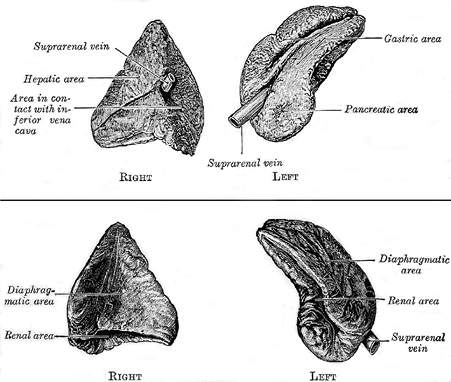 |
Figure 46.2 External appearance of anterior (above) and posterior aspects (below) of right and left adrenal glands. The right gland is pyramidal, and the left is crescent shaped. The right adrenal vein is short. The left vein is longer and lies in a groove on the anterior surface of the gland. (Reprinted with permission from: Goss CM, ed. Gray's Anatomy of the Human Body. 29th ed. Philadelphia: Lea & Febiger; 1973. ) |
Development
Cortex
The adrenal cortex is of mesodermal origin. Its primordia appear at the 9-mm embryo stage (6th week of gestation) as bilateral cellular aggregations (Figure 46.4) at the mesenteric root, medial to the developing gonad and anterior to the kidney (mesonephros) (4,5). These primordia are composed of two groups of mesenchymal cells: one destined to be the precursor of the transitory provisional or fetal cortex, the other to become the adrenal capsule and its supporting connective tissue framework (5). By the 7th week of gestation, the primordia have become more defined, have separated from the coelomic lining, and include polyhedral cells with eosinophilic, lipid-poor cytoplasm. These cells increase in size and proliferate rapidly, forming a series of parallel columns and cords of cells that ultimately compose the bulk of the provisional cortex. External to this dominant mass, a thin subcapsular
P.1169
rim of smaller cells (the precursor of the permanent or adult cortex) appears (Figure 46.5). These cells are arranged in nests and arches that cap the columns of deeper cells. They have hyperchromatic, closely packed, overlapping nuclei. The nuclei are larger, more vesicular, and less hyperchromatic in the cords. Continuous, spottily distributed degeneration of the cells is found in the cords, and dead cells (apoptosis) are continuously replaced by the proliferation of cells in the narrow subcapsular band. Growth of the developing cortex is therefore centripedal (from outside inward).
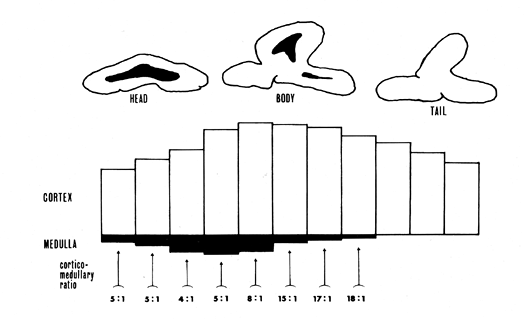 |
Figure 46.3 Diagrammatic illustration of the distribution of medulla (black) in the head, body, and tail of the adrenal gland (above) and corresponding corticomedullary ratios (below). (Reprinted with permission from: Symington T. Functional Pathology of the Human Adrenal Gland. Baltimore: Williams & Wilkins; 1969. ) |
At the end of gestation, the provisional cortex accounts for the bulk of the gland (Figure 46.6). Within hours of birth, it becomes acutely congested and starts to degenerate. At the end of 7 to 10 days, the provisional cortex is largely disorganized and necrotic. The narrow peripheral band of cell clusters survives and becomes the source of the permanent cortex.
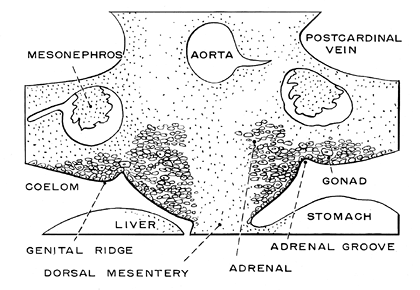 |
Figure 46.4 Diagrammatic representation of a human embryo at 6 weeks' gestation showing the anatomic relationship of developing adrenal gland to coelomic cavity, gonad, and kidney (mesonephros). (Reprinted with permission from: Dahl EV, Bahn RC. Aberrant adrenal cortical tissue near the testis in human infants. Am J Pathol 1962;40:587 598. ) |
Medulla
The adrenal medulla is of neuroectodermal origin (5). Precursor cells originate in the neural crest and migrate from primitive spinal ganglia (sixth thoracic to first lumbar) to form the primitive sympathetic nervous system situated dorsal to the aorta. Sympathogonia cells (from the sympathetic anlagen) migrate farther into nerves that sprout from the sympathetic chain, then move alongside large blood vessels that penetrate into the (as yet) unencapsulated fetal adrenal cortex, primarily at its caudal pole (head). [This very likely explains the nonuniform distribution of medulla in the adult adrenal mentioned previously.] The neural cells enter the adrenal primordium as fingerlike processes and pass among the fetal cortical cells. In this manner, sympathogonia and a plexus of nerves are initially scattered among fetal cortical cells (Figure 46.7). Two sets of progeny of the sympathogonia evolve: the majority, small cells with little cytoplasm and
P.1170
P.1171
a darkly staining nucleus (neuroblasts); the minority, larger cells with a vesicular nucleus and basophilic cytoplasm (pheochromoblasts). At birth, the medulla comprises a central, very thin core of these cells with offshoots stretching a short distance into the peripheral degenerating provisional cortex. The medullary cells are arranged in irregularly sized clumps containing both cell types, the larger cells now predominating. The postnatal collapse of the provisional cortex and its stroma removes the framework that supported the medullary offshoots and their associated nerve plexus in the cortex (3). With this loss of scaffolding, these structures coalesce around the central veins.
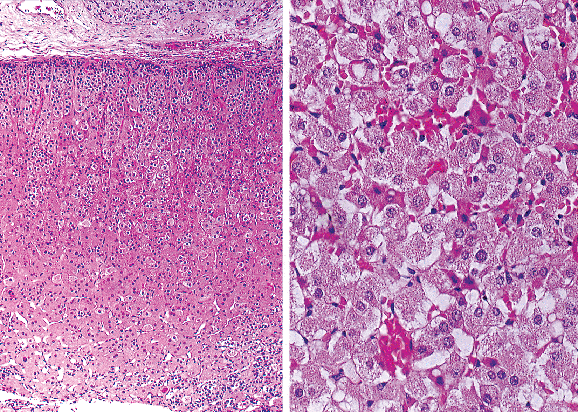 |
Figure 46.5 Provisional (fetal) cortex (29 weeks' gestation, stillborn infant). A. Cortex is dominated by large cells with eosinophilic cytoplasm in vague columns and solid sheet with prominent capillaries. Just beneath the tenuous capsule, there is a rim of smaller cells, the source of the permanent cortex. A sympathetic ganglion and a small nerve are present in the periadrenal connective tissue. B. Large, liverlike cells with cytoplasm that is voluminous, eosinophilic, and granular. Nuclei are vesicular with a single small nucleolus. Vascularity is prominent. |
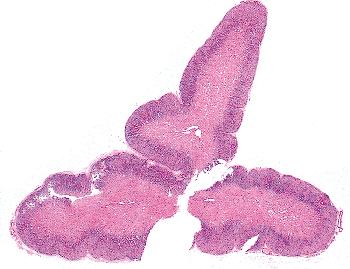 |
Figure 46.6 Adrenal cortex at birth (35 weeks' gestation; infant died at 2 days). The central, degenerating, eosinophilic provisional cortex is surrounded by the developing, darkly staining outer rim of permanent cortex. |
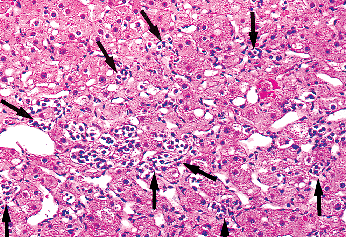 |
Figure 46.7 Developing adrenal medulla (29 weeks' gestation, stillborn infant). Clusters of small medullary cells with deeply staining nuclei (arrows) irregularly distributed in very vascular provisional cortex. When the latter degenerates, the clusters of medullary cells survive and, lacking the support of the cortical cells, aggregate together. |
Gland Weight and Cortical Thickness
Although not a structural feature of the adrenal, the weight of the glands is important because assessment of the adrenal normalcy takes this feature into account. Information on truly normal adrenal weight is difficult to obtain because the organ (specifically the cortex) responds rapidly to stress by an increase in mass. Therefore, accurate normal adrenal weight can be determined only from selected autopsy material (e.g., healthy individuals who die suddenly). The combined adrenal weight in these circumstances is about 8 9 g (1). Exceptionally, a gland weighs as little as 2 g or as much as 6 g. Sex differences are not apparent. Formalin fixation has little effect on the gland weight.
Relative to body weight, the adrenals are actually largest at the 4th month of gestation (2). In unselected autopsy cases, the combined average weight of the glands at birth is about 20 g. By the end of the 1st week of life, this mass has decreased (as a result of involution of the provisional cortex) to about 12 g, and a further small decrease occurs during the 2nd week, such that each gland comes to weigh approximately 5 g. Total gland weight then remains constant for 2 years, then gradually rises to the adult postmortem weight of about 13 g between 15 and 20 years of age (3).
The thickness of the normal adult adrenal cortex is approximately 1 mm and ranges from about 0.7 to 1.3 mm. For accuracy, the thickness should be determined microscopically with an ocular micrometer; it is impractical to detect small alterations in the thickness using a metric scale.
Adrenal Glands for Histologic Study
Ideal Material
Ideally, for the reasons already mentioned, adrenal glands used for study of normal histology of the organ should be obtained from healthy patients. Results obtained from the study of glands of patients with primary adrenal disease or disorders that might affect the adrenal histology secondarily should be used with caution. Nevertheless, because the two portions of the adrenal gland, cortex and medulla, are separate functional units that apparently do not affect each other, we think that it is not unreasonable (until shown to be otherwise) to study, for example, the histology of the adrenal medulla (thinking of it as being normal) in a gland surgically removed for a clinically and biochemically nonfunctioning small adrenocortical adenoma. Similar considerations apply to the cortex.
For study of cytologic detail, material should be fresh and not autolysed and therefore obtained at surgery or shortly after death. The zona reticularis of the cortex quickly begins to show the effects of anoxia (degeneration). However, glands that are less than optimally preserved for study of the cell details are satisfactory for determination of general microanatomy of the organ. In practice, fresh (and to a variable extent normal ) adrenal is most often available at the time of radical nephrectomy, in the course of which a gland is removed with the kidney. However, many such glands are torn during the surgical procedure, limiting to some extent their use for study of normal histology. Their usefulness is also limited in that they are representative only of the gland appearance in a particular age range (middle-aged or older patients). In practice, it is difficult to get the complete range of normal adrenal specimens (fetal to aged) that would be ideal for study of normal histology.
Actual Material
The actual tissue used for the histologic description that follows included adrenals from all the foregoing categories. Autopsy material was obtained from individuals (mostly male) who died suddenly (homicide, suicide, or traumatic injury). For some cases there was minimal or no medical history available, and the autopsy protocol and other autopsy slides could not be reviewed. Thus, the state of health of these patients and the condition of other organs could not be determined. A number of normal glands were available from patients undergoing nephrectomy. Also, opportunity was taken to study apparently normal extratumoral medulla and cortex in cases of adrenalectomy for certain primary adrenal neoplasms that were small or relatively small (adrenocortical adenomas producing aldosterone, nonfunctioning adrenocortical adenomas, and pheochromocytoma).
Histology
Blood Vessels
The blood supply of the adrenal gland has been studied mostly from the anatomic point of view, often by observing
P.1172
the distribution of injected material in the vasculature. The tone of the subcapsular vascular plexus controls circulation through the organ. The histologic appearance of the vessels distal to the plexus suggests that the intravascular pressure in the organ is low.
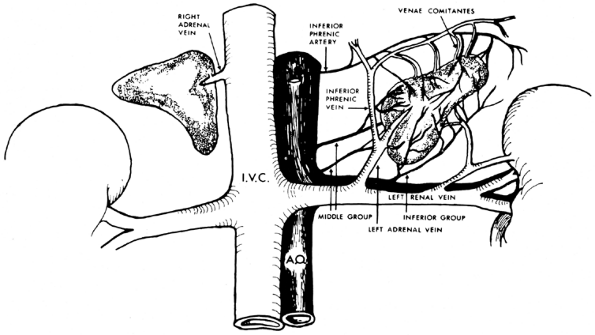 |
Figure 46.8 Diagrammatic representation of the arterial supply (black) and venous drainage (light and hatched) of the left adrenal gland. (Reprinted with permission from: Symington T. Functional Pathology of the Human Adrenal Gland. Baltimore: Williams & Wilkins; 1969. ) |
Arteries
Three separate groups of arteries superior, middle, and inferior arising from the inferior phrenic artery, the aorta, and the renal artery, supply each adrenal gland (Figure 46.8). The main vessels divide into 50 to 60 small feeder vessels that penetrate the anterior and posterior surfaces of the glands and form a plexus beneath the capsule of the gland. The former are commonly encountered close to the capsule of the gland; in older patients, they frequently exhibit atherosclerotic changes. The subcapsular plexus, important in regulation of the circulation in the gland, as has just been indicated, is not conspicuous in routine histologic preparations.
Intraglandular Vasculature
Capillary loops from the subcapsular plexus surround the cells of the zona glomerulosa (see Zona Glomerulosa ), then extend toward the interior of the organ between the columns of cells of the zona fasciculata, and ultimately open into wide interconnecting channels in the zona reticularis to form a second vascular plexus. This ends abruptly in a vascular dam at the corticomedullary junction that finally drains into the sinusoids of the medulla by relatively fewer channels. The marked vascular congestion commonly seen at the corticomedullary junction of adrenal glands obtained at autopsy may be a reflection of this vascular barrier. Although the medulla receives some arterial blood supply, most of its vascular supply has already nourished the cortex.
 |
Figure 46.9 Central adrenal vein. Low-power view of the vein surrounded by an invaginated cuff of cortical cells with clear cytoplasm (zona fasciculata type). Distribution of smooth muscle in the vein wall is uneven. The zona fasciculata (ZF) and zona reticularis (ZR) of the cortex are evident, and there is a small amount of basophilic medulla (M). |
P.1173
The venous drainage from the organs occurs via a single vein that emerges from the anterior surface of each gland (Figure 46.2). Inside the organs, the central adrenal vein (which ultimately becomes the adrenal vein as it leaves the organ) and its tributaries have a unique muscle coat, 2 to 6 longitudinally running muscle bundles, varying in size and eccentrically situated around the vein lumen (Figure 46.9). The bundles are heavily laden with elastic fibers that extend into tributaries of the larger central veins and in some instances outline clusters and trabeculae of medullary cells.
The eccentricity of the muscle bundles results in a vein wall that varies greatly in thickness and focally is devoid of muscle. In the zones where the muscle bundles are deficient (and these may be extensive), medullary cells (and sometimes cortical cells) are separated from the bloodstream by intima and a minimal amount of subintimal connective tissue only. This peculiar anatomic structure permits medullary cells or cortical cells to occasionally form polypoid endothelium-covered projections into the lumen of the central vein (Figure 46.10). (This ready access of pheochromocytes to the venous lumen explains the occasional finding of an intravenous tumor plug of pheochromocytoma.) A thick cuff of invaginated cortical cells surrounds the intramedullary central vein and its larger tributaries (Figure 46.10). (Development of a neoplasm in this displaced cortex probably explains the occasional cortical neoplasm that appears to have developed in the medulla of the organ. As explained later, there is another possible source for a cortical neoplasm in this location from cortical cells that occur among cells of the medulla.)
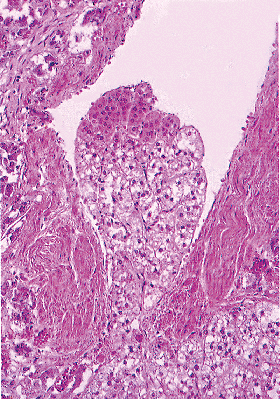 |
Figure 46.10 Central adrenal vein. Intraluminal protrusion of endothelium-covered adrenocortical cells between the discontinuous muscle bundles of a tributary of the central adrenal vein. |
Veins
The left adrenal vein, 2 to 4 cm in length, initially lies in a groove on the anterior surface of the gland and terminates in the left renal vein (Figures 46.2 and 46.8). The right adrenal vein is short (1 5 mm) and drains into the inferior vena cava (Figures 46.2 and 46.8). Histologically, the extra-adrenal and immediately intra-adrenal portions of the veins have a muscular coat composed of large, similarly sized, evenly disposed smooth muscle bundles, arranged side by side a structure found in other veins of this size.
Nerves and Ganglia
The innervation of the adrenal gland, specifically of the medulla, emanates from the lower thoracic segments of the spinal cord and passes through the greater splanchnic nerve and the upper lumbar sympathetic ganglia via the celiac plexus. This nerve supply forms a plexus of medullated and nonmedullated nerves on the capsule of the gland, primarily on its posterior aspect. Thus, the largely preganglionic nerve fibers pass into the medulla following either the course of emerging or penetrating vessels or connective tissue trabeculae. Occasionally, a large nerve penetrates directly into the medulla. The number of nerves visible in the medulla varies greatly from case to case; some feature a perineurium, whereas others do not; frequently, they have associated ganglion cells (Figure 46.11). Ganglion cells are also commonly seen singly or in clusters among the pheochromocytes (Figure 46.12). The cells of the cortex do not have a nerve supply.
Lymphatics
Injection studies have demonstrated that there is a rich plexus of lymphatic channels in the capsule of the gland (3). Lymphatics are distributed to the adventitia of the central vein and its main tributaries. There is no lymphatic supply to the cortex. The lymphatics drain into aortic lymph nodes.
Capsule
The capsule of the adrenal gland is composed of hypocellular fibrous tissue in the form of coarse, hyalinized collagen bundles and elastic fibers (Figure 46.13). Usually, the capsule is thin, but it varies considerably in thickness from gland to gland and even within the same gland (Figure 46.14). It is tough and hard to cut but tears easily and does
P.1174
P.1175
not support the unfixed gland, which is limp and readily bends. The soft consistency of the fresh glands makes them difficult to section; cooling them for 15 minutes in a refrigerator facilitates this operation.
 |
Figure 46.11 Adrenal medulla. Unusual concentration of nerves, some with perineurium and others without. |
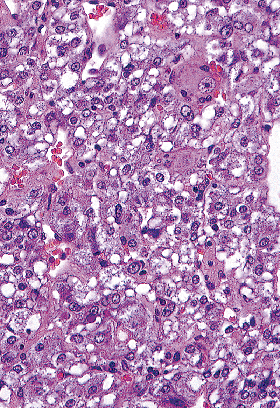 |
Figure 46.12 Adrenal medulla. Sheet of medullary cells with cytoplasm that is nonhomogeneous, variably basophilic, granular, and vacuolated, resulting in a mottled appearance. A ganglion cell is present among the pheochromocytes. |
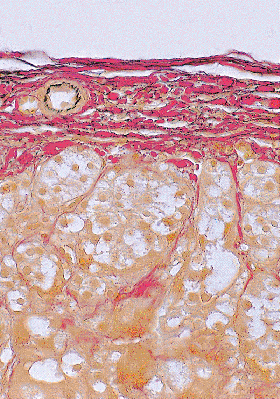 |
Figure 46.13 Adrenal capsule. Elastic van Gieson stain shows collagen bundles (red) and intermingled elastic fibers (black). A small artery is present in the capsule. |
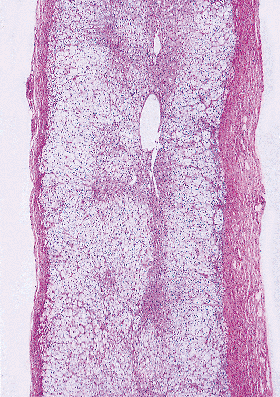 |
Figure 46.14 Adrenal capsule. Four-fold variation in the thickness of the capsule, which at its maximum thickness measures 0.3 mm. |
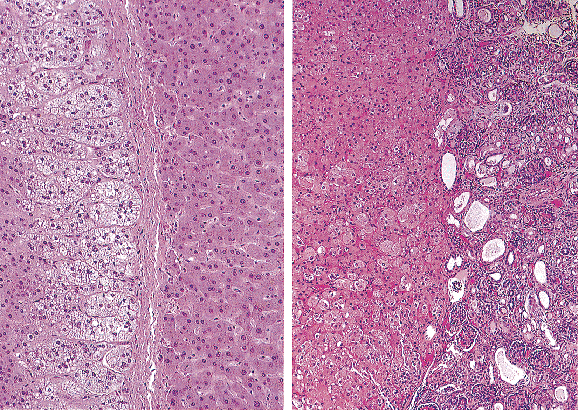 |
Figure 46.15 Adrenal capsule. A. Common capsule of adrenal (left) and liver (right). Note that a zona glomerulosa is not evident in the adrenal cortex. B. Absence of an adrenal and kidney capsule results in direct contact of adrenal cortex (provisional) and renal parenchyma. |
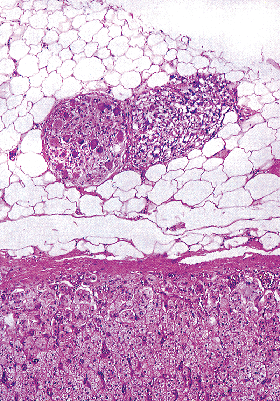 |
Figure 46.16 Normal adrenal gland. Juxtaposed sympathetic ganglion (above left) and paraganglion (above right) in periadrenal adipose tissue. The adrenal cortex features cells with clear cytoplasm (zona fasciculata). Zona glomerulosa is not evident. |
Because of the propinquity of development of adrenals and kidneys and the liver (on the right side), there is occasional fusion or sharing of a common capsule among the adrenal and kidney and the adrenal and liver (Figure 46.15). The common capsule may be deficient focally, and then parenchymal cells of two organs come into direct contact. The adrenal capsule is surrounded by adult-type fat (brown fat in the fetus and newborn) that features small arteries, veins, nerves, accessory cortex, excrescences of cortex, sympathetic ganglia, and an occasional paraganglion (Figure 46.16).
The capsule is penetrated by blood vessels supplying and draining the gland, the nerves to the medulla, and lymphatic channels. In random sections of the glands, only the site of exit of the adrenal vein is regularly encountered (because of its relatively large size); occasionally, the site of penetration of a large nerve is seen; the entry sites of the small arteries into the glands are also sometimes seen. Commonly found are narrow (occasionally wide) defects in the capsule through which the cortex protrudes into the periadrenal fat to form small nodules of cells that are sometimes delimited by a distended and attenuated adrenal capsule, sometimes not (Figure 46.17).
P.1176
These excrescences are composed predominantly of epithelial cells with normal zonation patterns among the cells. The protrusions may contain a connective tissue component, and sometimes there is an equal mixture of cords of epithelial cells and fibrous tissue. Single rows and groups of cortical cells, small and oval or large and round, are commonly found here and there in capsular pockets (Figure 46.18). Larger oval aggregates cause a slight depression in, and thinning of, the underlying cortex, so that the total width of the two portions of cortex that in the capsular pocket and that normally situated is about normal (Figure 46.18).
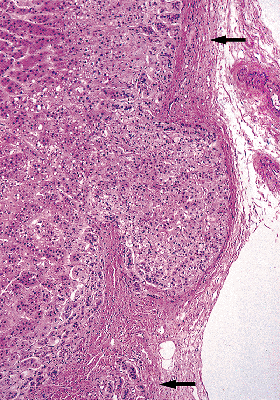 |
Figure 46.17 Normal adrenal gland. Protrusion of cortical cells surrounded by attenuated capsule through a wide defect in the adrenal capsule. A few cortical cells in rows and small aggregates are present in the capsule (arrows). A suggestive zona glomerulosa is present deep to the adrenal capsule (top). |
Sometimes seen attached to the capsule are wedge-shaped foci of small, plump spindle cells with hyperchromatic nuclei. These protrude into the cortex to varying depths and may be present bilaterally (Figure 46.19). The cells are arranged in interlacing bundles and whorls. Largely because of their light microscopic resemblance to ovarian cortical stroma, these aggregates have been termed ovarian thecal metaplasia ; an alternative interpretation is that they represent areas of adrenocortical blastema that for unknown reasons have failed to mature (6,7,8). These foci undergo fibrosis, hyalinization, and sometimes calcification. Nests of cortical cells are occasionally found in the spindle cell proliferation, presumably entrapped.
Exceptionally, the proliferations penetrate into the medulla as increasingly narrow tongues of tissue. Ovarian thecal metaplasia is said to occur in postmenopausal women, occasionally in premenopausal women, and exceptionally in old men. We have not seen it in any of the normal adrenal glands we have examined despite a good search. However, we have encountered it fairly commonly in the extratumoral cortex associated with a range of functioning adrenocortical adenomas and in adrenals removed for other pathology, cortical and medullary, always in perimenopausal or postmenopausal females. The lesions are generally incidental microscopic findings that were not recognized grossly.
Cortex
Traditionally, the cortex has been divided into three areas based on light microscopy findings from the capsule inward the zona glomerulosa, the zona fasciculata, and the zona reticularis forming the typical zonation pattern of the adrenal cortex (Figure 46.20). The functional significance of this morphologic separation is questionable, but the zona glomerulosa is the site of aldosterone production and is responsive to angiotensin and potassium, and the zona fasciculata and zona reticularis synthesize glucocorticoids and sex hormones. Cells of all zones respond to adrenocorticotropic hormone (ACTH). Recent studies using monoclonal antibodies have shown some differential staining of the normal human cortical parenchyma (9). Division figures are rare in the normal adult cortex; in fact, the zone(s) of normal proliferation for replacement of effete cells is not known, although it is believed to be near the periphery of the cortex. [Under the influence of increased circulating levels of ACTH (Cushing's disease), mitotic figures may be seen in the zona fasciculata and zona reticularis, indicating that cells in the deeper areas of the cortex are also capable of proliferating.]
A number of modern techniques for studying cell proliferation and programmed cell death (apoptosis), specifically, KI-67 immunostaining and 3 -OH nick end-labeling method, respectively, have been applied to study of the human adrenal cortex (10). Cell proliferation as indicated by KI-67 immunoreactivity occurred principally in the zona fasciculata. Cortical cells positive for nick-end labeling (apoptotic) were uniformly present in the zona reticularis and in the zona glomerulosa in one third of cases. The findings suggest that cortical cells may disperse in two directions, centripetally and centrifugally, from the zona fasciculata to the zona reticularis and from the zona fasciculata to the zona glomerulosa, in some cases. Biochemically, apoptosis features chromatin cleavage. Morphologically, there is shrinkage of cytoplasm, condensation, and fragmentation of nuclei and membrane blebbing. Adrenocortical cells undergoing apoptosis are believed to be phagocytosed by histiocytes and cells lining the sinusoids.
P.1177
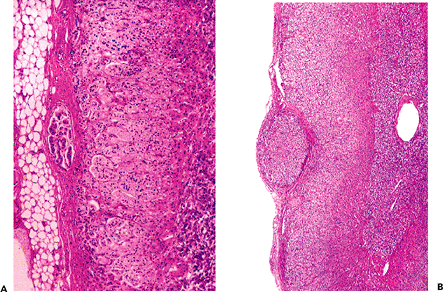 |
Figure 46.18 Normal adrenal gland. A. Aggregate of cells with features of zona glomerulosa type in pocket in capsule. B. Cortex featuring zona fasciculata (clear cells) and zona reticularis (compact cells) abuts medulla. A larger aggregate of cortical cells with clear (peripheral) and compact cytoplasm (central) is present in a pocket in the capsule. The cortex deep to the pocket is slightly attenuated. A zona glomerulosa is not clearly visible. |
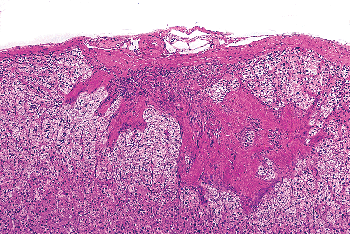 |
Figure 46.19 Ovarian thecal metaplasia (63-year-old woman with a 2-cm aldosterone-producing adrenocortical adenoma). A group of packed spindle cells is attached to the adrenal capsule. Nests of cortical cells are trapped by hyalinized fibrous tissue. A poorly defined zona glomerulosa is present). |
Nucleolar organizer regions, loops of ribosomal DNA that appear to be an indicator of cellular and nuclear activity, have been studied to a limited degree in the human adrenal cortex, using a silver technique and formalin-fixed, paraffin-embedded tissue (11).
Zona Glomerulosa
The zona glomerulosa is the narrow, inconstant band of cortex situated immediately beneath the capsule and superficial to the zona fasciculata (Figure 46.21). Sometimes it can be identified throughout a section or over a large portion of one as a distinct rim beneath the capsule; more often it cannot. Where it is deficient, the zona fasciculata extends to the capsule (Figure 46.22). The zone is often easier to identify
P.1178
in autopsy preparations. In routine hematoxylin and eosin preparations, the band may merge with and be separated with difficulty from the outer cells of the zona fasciculata.
 |
Figure 46.20 Normal adrenal gland. A thick capsule surrounds the adrenal cortex (outer clear zona fasciculata and inner eosinophilic zona reticularis) that encloses the basophilic adrenal medulla. An area of medulla in the ala (arrow) is not in continuity with the main mass of medulla. The adrenal vein is surrounded by a cuff of invaginated cortex. |
 |
Figure 46.21 Normal adrenal gland. A. The normal pattern of zonation of the cortex is seen (clusters of cells with stainable cytoplasm in the zona glomerulosa, columns of cells with clear cytoplasm in the zona fasciculata, and cells with acidophilic cytoplasm in the zona reticularis). There is a sharp interface between the cortex (zona reticularis) and medulla (clusters of cells with basophilic cytoplasm). B. Zona glomerulosa composed of packed clusters and short trabeculae of cells beneath the adrenal capsule and superficial to the columns of vacuolated cells of the zona fasciculata. The zona glomerulosa nuclei tend to be oval; those of the zona fasciculata are round. |
The zona glomerulosa cells are well outlined and aggregated into small clusters that are supported by a minimal amount of fibrovascular stroma (Figure 46.21). The clusters occasionally merge into short trabeculae, straight, bent, or hairpin shape. The cells that tend to be columnar also occur in short cords or one-cell rows set parallel to the capsule. The cytoplasm is faintly acidophilic or amphophilic and minimally to distinctly vacuolated. The round nuclei sometimes are indistinguishable from those of the other zones of the cortex, but often they appear slightly smaller and more deeply staining. Commonly, they are ellipsoidal and elongated and display a longitudinal groove, a nuclear configuration not seen in the deeper areas of the cortex (Figure 46.21). The nuclear to cytoplasmic ratio is high.
Zona Fasciculata
The zona fasciculata is a broad band, more than half the thickness of the cortex, that lies between the zona glomerulosa (superficial) and the zona reticularis (deep) (Figures 46.20, 46.21, and 46.23). The transition between the zones is not sharp. The zona fasciculata cells are large, have distinct cell membranes, are arranged in two-cell wide cords (with the cord axes perpendicular to capsule) and are bounded laterally by parallel-running capillaries. The nuclei are more vesicular and less chromatic than those of the zona glomerulosa, feature a single small nucleolus, and are central in the cells. Especially in the outer two thirds of the zone, the cells are filled with lipid (cholesterol, fatty acids, and neutral fat), much of which is birefringent (Figure 46.24). Because this lipid is dissolved with the usual technical procedures, the fasciculata cells have a spongy, vacuolated, clear appearance and are often referred to as clear cells. When frozen, and sections are stained with a vital dye or stained for fat, the large amount of intracellular lipid can be appreciated (Figure 46.24). The yellow color of the zone seen grossly is due to this high lipid content.
Zona Reticularis
The zona reticularis lies deep to the zona fasciculata, and in the head and body of the gland abuts on the medulla (Figures 46.9, 46.20, 46.21, and 46.23). In the tail of the gland,
P.1179
where there is no medulla, the zona reticularis is in contact with zona reticularis forming a lateral raphe. It constitutes approximately one quarter of the thickness of the cortex. Zona reticularis cells are arranged in a spongelike meshwork of gently buckled anastomosing one-cell wide rows of cells that are separated by dilated capillaries. The well-outlined cells are smaller than those of the zona fasciculata and have cytoplasm that is granular, acidophilic, and relatively lipid sparse. The cytoplasm is sometimes referred to as compact and the reticularis cells as compact cells. The deepest cells adjacent to the medulla usually contain yellow lipochrome pigment (lipofuscin), diffusely distributed as coarse granules in the cytoplasm or localized in a single body (Figure 46.25). The yellow pigmentation of the cytoplasm extends outward into the reticularis for a variable distance. The solid granular eosinophilic cytoplasm and the lipochrome pigment combine to produce the dark brown coloration of the zone seen on cut surface of a fresh or formalin-fixed gland.
 |
Figure 46.22 Normal adrenal cortex with discontinuity of zona glomerulosa. Zona glomerulosa (upper half) composed of clusters of cells with amphophilic cytoplasm forms a distinct band beneath the capsule and is sharply demarcated from the deeper zona fasciculata with its clustered cells having clear cytoplasm. Where the zona glomerulosa is absent (lower half), the zona fasciculata extends to the capsule. |
Accessory (Heterotopic) Adrenal
The adrenocortical primordium initially is unencapsulated and develops, as has been mentioned, close to the emerging gonad. Therefore, it is not surprising that (a) some cells of the unencapsulated adrenocortical primordium may become associated with and migrate alongside the gonad (testis or ovary) to be found postnatally distant from the adrenal in the path of gonad descent and (b) cortical cells not sequestered by adrenal capsule formation are subsequently found in the retroperitoneal fat close to the adrenal glands. In practice, accessory adrenocortical tissue is most often encountered around the adrenal glands themselves (Figure 46.26); it also occurs in the inguinal region and around the ovary, fallopian tube, epididymis, and rete testis. Microscopically, accessory cortex shows normal zonation and responds to ACTH. Rarely, medulla is also present (Figure 46.26).
Adrenocortical Nodules
Adrenocortical nodules, roughly spherical, uncapsulated areas of hypertropic and hyperplastic cortical cells, are not regarded as true neoplasms. They range in size from microscopic to grossly obvious lesions (12). Before the fourth decade of life, they are rare; thereafter, they are encountered with increasing frequency. Although
P.1180
regarded by some as an aging phenomenon, they are not invariably found in older individuals. Usually, multiple nodules commonly consist of large, lipid-laden clear cells; some nodules are composed of clear and compact cells; a minority feature reticularis-type cells only (Figure 46.27). The smallest nodules may be found at any level of the cortex, but usually they occur in the zona fasciculata. Initially, they appear to be the result of hypertrophy of contiguous cells in three or more adjacent cords. The smallest ill-defined nodules thus have the cord structure of the parent tissue. As they enlarge further due to cell proliferation, this organized appearance is lost, and larger nodules are patternless. Large nodules cause compression and distortion of the surrounding cortex.
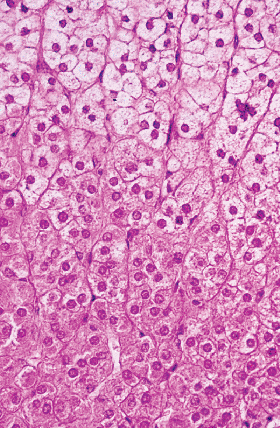 |
Figure 46.23 Normal adrenal cortex. Zona fasciculata (upper) features two-cell wide columns of cells with clear cytoplasm, and zona reticularis (lower) consists of cells having acidophilic granular cytoplasm that do not form a distinct pattern. Nuclei are vesicular, and nucleoli are small. |
 |
Figure 46.24 Normal adrenal cortex. A. Partial polarization shows high lipid content of zona fasciculata and low content of zona glomerulosa (above) and zona reticularis (below). B. Fresh frozen section of adrenal cortex stained with polychrome methylene blue. One complete band of cortex (above) and portion of another (below) is seen; the junction point between the two is located by the dilated sinusoidal tributaries of the central adrenal vein. Zona fasciculata cells are packed with lipid globules. There are fewer globules in the zona glomerulosa (beneath the adrenal capsule) and in the zona reticularis (on either side of the sinusoidal vessels). |
Medulla
The medulla is situated in the interior of the organ in the head and body of the gland, deep to the zona reticularis (Figures 46.9 and 46.20). Its area and weight are one tenth those of the cortex (1,3). The medulla rarely measures more than 2 mm in thickness. Because of the different staining of cells of the two tissues acidophilia in zona reticularis and basophilia in the medulla the interface between cortex and medulla is readily visible on low-power microscopic examination. The junction is sharp, with no or minimal intervening connective tissue, leaving cortical and medullary cells in direct contact (Figures 46.20 and 46.25).
The medulla extends to a variable extent into the crest of the gland (the ridge on the posterior surface) and into one or both of the alae (Figure 46.20). Areas of the medulla in the alae are not necessarily in direct continuity with the main mass of the medulla around the central veins. The medulla sometimes extends into the tail of the gland. The finding of medulla in this location therefore does not automatically equate with pathologic abnormality specifically, medullary hyperplasia. Rarely, a narrow tongue of medulla accompanied by a vessel or nerve or unaccompanied extends through the cortex to contact the capsule of the gland.
The medulla, for practical purposes, is composed of a single cell population, the pheochromocytes (medullary or chromaffin cells) (Figure 46.28). Among the dominant population are scattered small groups of cortical cells and clusters and individual ganglion cells (Figure 46.29). Not
P.1181
uncommonly, the ganglion cells feature cytoplasmic, round, lightly acidophilic, hyalin bodies, with concentrically arranged fibrillar appearance, up to 30 m in diameter (Figure 46.30). Sometimes these bodies appear to be external to the ganglion cells and to indent them; in immunostain preparations (vimentin and S-100) they are separated from the cells by a small amount of intercellular substance. It is unusual to observe these bodies in ganglion cells outside the adrenal medulla. Their nature has not been investigated. The pheochromocytes are arranged in tight clusters and short trabeculae, supported by delicate fibrovascular stroma (Figures 46.28 and 46.31). Sustentacular cells at the periphery of the clusters and trabeculae are not seen in routine histologic preparations (13), but are readily demonstrated by immunostaining for S-100 protein (Figure 46.32).
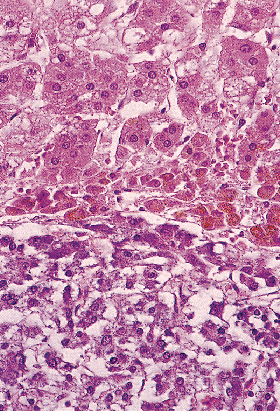 |
Figure 46.25 Corticomedullary junction. The zona reticularis of the cortex (upper) is sharply demarcated from the medulla (lower). The deepest cells of the zona reticularis contain granular yellowish pigment (lipofuscin). |
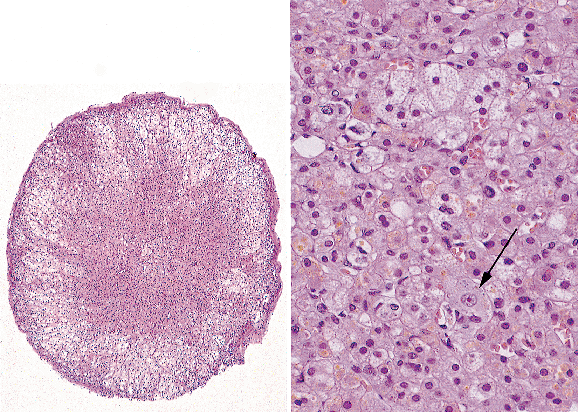 |
Figure 46.26 Accessory adrenal cortex in retroperitoneal fat. A. Normal zonation is suggested by the narrow rim of cells with clear cytoplasm that surrounds the main mass of cells with light eosinophilic cytoplasm. B. Ganglion cell (arrow) indicating presence of medulla among cortical clear and compact cells. The latter contain lipofuscin. |
The pheochromocytes are moderately large cells, polygonal to columnar, and slightly to considerably larger than cortical cells. Poorly outlined, their complete cell borders are visible only occasionally. Although the cytoplasm of most medullary cells is basophilic, finely granular and occasionally vacuolated, sometimes it is amphophilic or slightly acidophilic. Rarely is it partly basophilic and partly acidophilic. The resulting variability and unevenness of medullary cytoplasmic staining and cytoplasmic vacuolization often impart an overall mottled light and dark appearance at intermediate
P.1182
P.1183
magnification. A rare normal cell has one or more periodic acid-Schiff positive cytoplasmic colloid droplets (Figure 46.33). The majority of the medullary cells are roughly similar in size, but occasionally standard-sized cells merge with groups of cells that are much smaller or much larger (Figure 46.31).
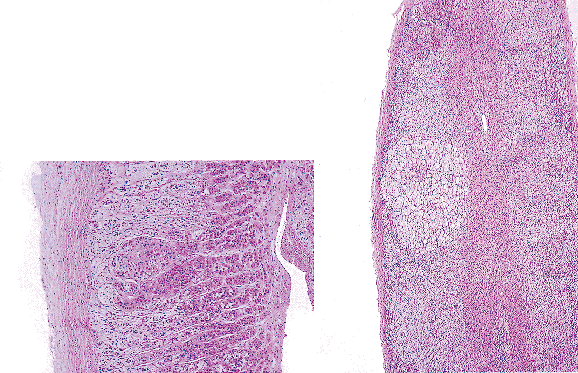 |
Figure 46.27 Cortical nodules (36-year-old man). A. Suggestive nodule in the mid-cortex.B. Distinct nodule composed of clear cells in outer cortex. |
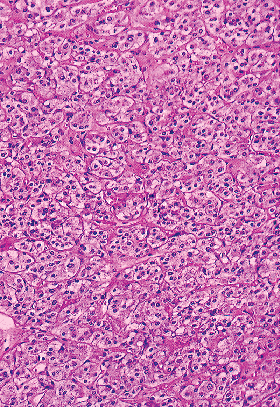 |
Figure 46.28 Normal adrenal medulla. Clusters of poorly outlined cells with basophilic cytoplasm are separated by a vascularized supporting stroma. There is some variation in nuclear size and shape. |
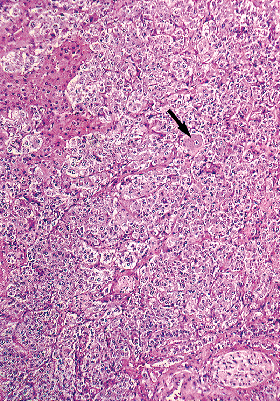 |
Figure 46.29 Normal adrenal medulla. Pheochromocytes are arranged in poorly delineated clusters. An irregularly shaped group of cortical cells (upper left) and an isolated ganglion cell (arrow) are present. |
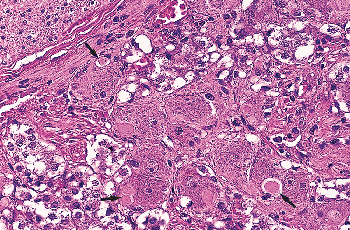 |
Figure 46.30 Normal adrenal medulla. A group of ganglion cells demarcated by pheochromocytes (upper right and lower left) and a nerve (upper left). A number of the ganglion cells feature cytoplasmic acidophilic bodies, some outlined by a rim of retracted cytoplasm (arrows). There are two such bodies in one cell. |
 |
Figure 46.31 Normal adrenal medulla. A. Pheochromocytes arranged in vague clusters. Cell outlines are visible here and there. Nuclear variation in size and shape is typical. The nuclear chromatin is coarsely clumped and often marginated at the nuclear membrane. B. Variation in cell size, nuclear size, and cell pattern. |
The nuclei of medullary cells characteristically have slight but definite variability of size, shape, and location in the cell. Most pheochromocyte nuclei are slightly larger than those of cortical cells, but nuclei that are larger and smaller than the usual ones are common. The usual nucleus has a finely or coarsely clumped chromatin pattern with a relatively clear nuclear background (Figure 46.31). The chromatin tends to be peripherally disposed and separated into irregular clumps. Larger nuclei often have a prominent eosinophilic nucleolus; smaller nuclei are deeply staining. A rare cell has two or more nuclei.
The nuclei exhibit slight but definite polymorphism. Most are spheroidal, but many are ellipsoidal, and some have other shapes. Large, intensely hyperchromatic and sometimes pleomorphic nuclei are common, usually single and located close to the corticomedullary junction (Figure 46.34). The positions of the nuclei in the cells are not fixed; most are central, but some tend to be eccentric, located away from the vascular pole (Figure 46.35).
The medullary cells have several distinctive histochemical reactions related to their content of secretory granules. The granules contain catecholamines, dihydroxy derivatives of tyrosine, that are converted to colored polymers by oxidizing agents such as potassium dichromate, ferric chloride, ammoniacal silver nitrate, and osmium tetroxide. The oxidized and polymerized derivatives are termed
P.1184
P.1185
adrenochromes. This staining has been called the chromaffin reaction.
 |
Figure 46.32 Normal adrenal medulla. A. Pheochromocytes arranged in trabecular pattern outlined by a delicate vascular supporting stroma. B. Sustentacular cells identified by S-100 immunostain that also highlights two nerves. |
 |
Figure 46.33 Normal adrenal medulla. Cytoplasmic globules, a rare finding in normal pheochromocytes, stained with periodic acid-Schiff. Condensation of the nuclear chromatin at the nuclear membrane is well demonstrated. |
 |
Figure 46.34 Normal adrenal medulla. Pheochromocyte nuclear atypia at the corticomedullary junction. The number of atypical pheochromocyte nuclei crowded together here is unusual; ordinarily, the atypical nuclei are seen one to a medium-power field. The pheochromocytes have basophilic granular cytoplasm. The zona reticularis (left) features cells with granular eosinophilic cytoplasm and lipofuscin. |
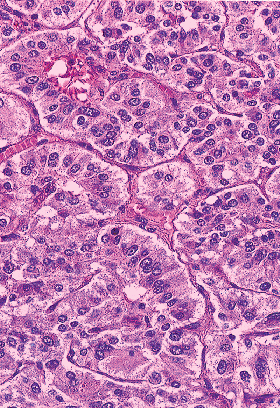 |
Figure 46.35 Normal adrenal medulla. Uncommon pattern in which pheochromocytes are columnar in shape with nuclei that are located away from the vascular pole. The variations in size and shape of the nuclei are typical. Cytoplasmic staining is uneven and ranges from almost clear to basophilic and granular. |
 |
Figure 46.36 Normal adrenal medulla. Aggregates of lymphocytes and plasma cells are often encountered. |
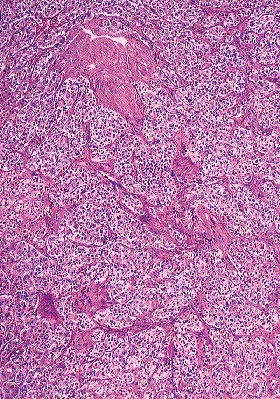 |
Figure 46.37 Normal adrenal medulla. Bundles and strands of smooth muscle are derived from the smooth muscle of central vein. |
Ganglion cells are scattered randomly among the pheochromocytes or in groups, often associated with a nerve (Figure 46.29). Their number varies greatly from medulla to medulla; accordingly, they are found easily or not. Cortical cells also are a regular component of the medulla, found in irregularly shaped groups, sometimes in continuity with the zona reticularis, but more often not (Figure 46.29).
Single or multiple small-to-large accumulations of round cells, plasma cells, and lymphocytes (positive for leukocyte common antigen), often paravascularly located, are common in the normal medulla (Figure 46.36). They have no known significance. The delicate vascular stroma of the medulla is not conspicuous. Sometimes it is augmented focally by prolongations of the musculature of the central veins that separate groups of medullary cells (Figure 46.37).
Immunohistochemistry
Cortex
Cells of the normal adrenal cortex are reported to be immunoreactive against a cytokeratin cocktail and AE1 (14). In our experience, small groups of cells and isolated cells of the three zones have strong reactivity to low- and medium-molecular-weight keratin antibodies (CAM 5.2 and AE1, and MAK 6, respectively). Reactivity is greatest in the zona
P.1186
glomerulosa and external zona fasciculata, with some strongly reactive cells in the deep zona reticularis. The character of the staining is variable, membranous, punctate cytoplasmic, diffuse cytoplasmic, and perinuclear, in decreasing order of frequency. There is weak staining to the keratin antibodies, often diffuse, in the zona reticularis. The zona glomerulosa is vimentin positive (Figure 46.38). Cells of the outer zona fasciculata and the zona reticularis are positive for melan A and inhibin , respectively (Figure 46.39). Cells of the three zones are variably synaptophysin positive. Cortical cells do not stain with epithelial membrane antigen, chromogranin, or S-100 antibodies.
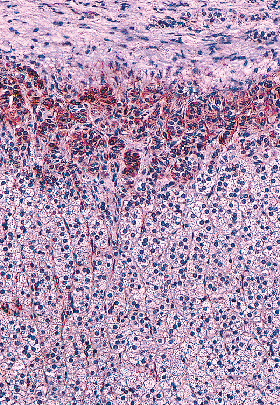 |
Figure 46.38 Normal adrenal cortex. Zona glomerulosa stains positively for vimentin. |
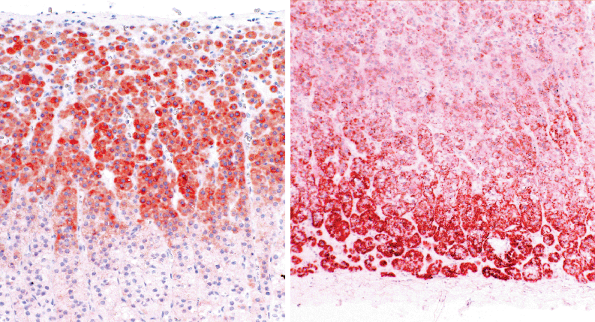 |
Figure 46.39 A. Melan A stains the outer zona fasciculata most strongly. B. Inhibin stains the region of the zona reticularis strongly and the remainder of the cortex weakly. |
Medulla
Pheochromocytes stain with antibodies to chromogranin and synaptophysin. The sustentacular cells that mantle the clusters and trabeculae of pheochromocytes are S-100 protein positive (Figure 46.40), as are nerves in the medulla. Some pheochromocytes stain with S-100 antibodies.
Ultrastructure
Cortex
There are ultrastructural features shared by the three layers of the cortex relating to their common function synthesis of steroid hormones. The cells feature voluminous endoplasmic reticulum, stacks of rough endoplasmic reticulum, a well-developed Golgi apparatus, lysosomes, and many mitochondria. The distribution and internal structure of some of the organelles (e.g., the mitochondria) vary from zone to zone. Using the electron microscope, the sometimes distinct transition seen between the zones is not apparent; rather, a gradual alteration from one organelle distribution and type to another being observed. Mitochondria in the zona glomerulosa are round, oval, or elongate, with lamellar infolded cristae, resulting in a ladderlike internal structure, similar to that found in many other
P.1187
P.1188
tissues (Figure 46.41). In the zona fasciculata, these organelles are large, spherical, and feature tubular cristae (Figure 46.41). Lipid droplets are large and numerous. The mitochondria in the zona reticularis (Figure 46.41) tend to be more elongated and exhibit tubular and vesicular cristae that are a feature of steroid-producing cells. Lipofuscin granules, membrane-bound organelles with a moderately dense matrix that contains dense granules and clear lipid globules are prominent. Glycogen is present.
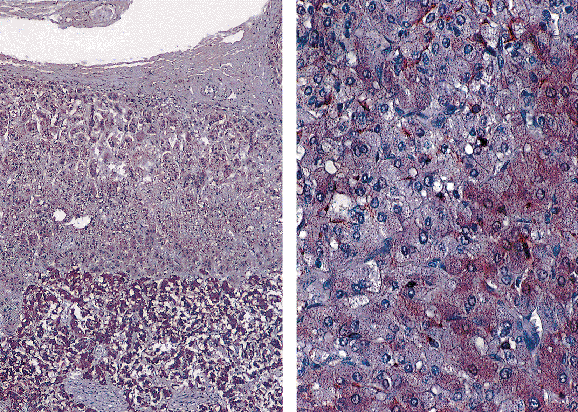 |
Figure 46.40 Normal adrenal medulla. A. Medulla (below) stains with chromogranin antibodies; cortex is unstained. B. Sustentacular cells and about one half of the pheochromocytes are stained by S-100 protein antiserum. |
 |
Figure 46.41 Normal adrenal cortex. A. Electron micrograph of mitochondria in the zona glomerulosa have lamellar pattern. B. Mitochondria in the zona fasciculata have a tubular and vesicular pattern. C. Mitochondria in the zona reticularis are elongated and have a vesicular appearance. Bar =1 m. |
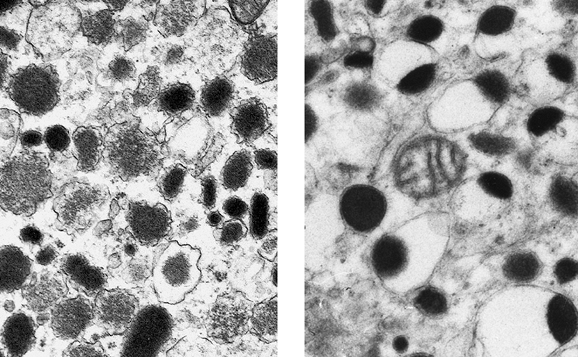 |
Figure 46.42 Normal adrenal medulla. Electron micrographs of medullary secretory granules. A. Epinephrine granules with a variably electron-dense content that fills the majority of the sacs. B. Content of norepinephrine granules is electron dense and often eccentrically located. Bar = 1 m. |
Medulla
Catecholamine-secreting cells dominate the medulla. Two cell types, epinephrine and norepinephrine, distinguished by granule type are present. In tissue fixed in glutaraldehyde, cells that contain epinephrine feature granules (Figure 46.42) measuring about 190 m in diameter, with a finely granular texture that is moderately dense but not opaque, and fills the enclosing membrane. Norepinephrine-secreting cells have granules (Figure 46.42) that are electron opaque, often located eccentrically within a dilated sac, and measure about 250 m in diameter.
References
1. Quinan C, Berger AA. Observations on human adrenals with especial reference to the relative weight of the normal medulla. Ann Intern Med 1933;6:1180 1192.
2. Ekholm E, Niemineva K. On prenatal changes in the relative weights of the human adrenals, the thymus and the thyroid gland. Acta Paediatr 1950;39:67 86.
3. Symington T. Functional Pathology of the Human Adrenal Gland. Baltimore: Williams & Wilkins; 1969.
4. Keene MFL, Hewer EE. Observations on the development of the human suprarenal gland. J Anat 1927;61:302 324.
5. Crowder RE. The development of the adrenal gland in man, with special reference to origin and ultimate location of cell types and evidence in favour of the cell migration theory. Carnegie Inst Contrib Embryol 1957;26:193 210.
6. Reed RJ, Patrick JT. Nodular hyperplasia of the adrenal cortical blastema. Bull Tulane Univ Med Faculty 1967;26:151 157.
7. Wong TW, Warner NE. Ovarian thecal metaplasia in the adrenal gland. Arch Pathol 1971;92:319 328.
8. Fidler WJ. Ovarian thecal metaplasia in adrenal glands. Am J Clin Pathol 1977;67:318 323.
9. Backlin C, Juhlin C, Grimelius L, et al. Monoclonal antibodies recognizing normal and neoplastic human adrenal cortex. Endocr Pathol 1995;6:21 34.
10. Sasano H, Imatani A, Shizawa S, Suzuki T, Nagura H. Cell proliferation and apoptosis in normal and pathologic human adrenal. Mod Pathol 1995;8:11 17.
11. Sasano H, Saito Y, Sato I, Sasano N, Nagura H. Nucleolar organizer regions in human adrenocortical disorders. Mod Pathol 1990;3:591 595.
12. Dobbie JW. Adrenocortical nodular hyperplasia: the ageing adrenal. J Pathol 1969;99:1 18.
13. Nakajima T, Kameya T, Watanabe S. S-100 protein distribution in normal and neoplastic tissues. In: DeLellis RA, ed. Advances in Immunohistochemistry Vol 3. New York: Masson; 1984:141 158.
14. Gaffey MJ, Traweek ST, Mills SE, et al. Cytokeratin expression in adrenocortical neoplasia: an immunohistochemical and biochemical study with implications for the differential diagnosis of adrenocortical, hepatocellular, and renal cell carcinoma. Hum Pathol 1992;23:144 153.